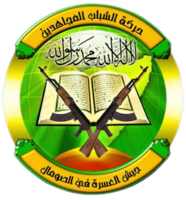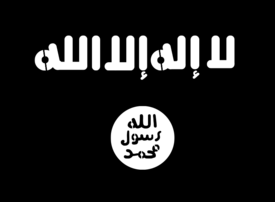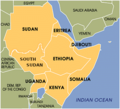Al-Shabaab (militant group) facts for kids
Quick facts for kids Al-Shabaab |
|
|---|---|
| حركة الشباب المجاهدين Participant in Somali Civil War
|
|
| Active | August 2006–present |
| Ideology |
|
| Founder | Aden Ayro † (2006–2008) |
| Leaders |
|
| Headquarters | |
| Area of operations | |
| Part of | |
| Allies | State allies
|
| Opponents | State opponents
|
Al-Shabaab is a group based in Somalia that is also active in other parts of East Africa. Its full name is Harakat al-Shabaab al-Mujahideen, which means "Movement of the Mujahideen Youth" in Arabic. The group is involved in the ongoing Somali Civil War. It combines ideas of Somali nationalism with its own religious beliefs. Since 2012, Al-Shabaab has been linked to al-Qaeda, a well-known militant organization.
Al-Shabaab started in the mid-2000s as a youth group within the Islamic Courts Union. This was a larger group that controlled much of Somalia. Al-Shabaab became more widely known during the Ethiopian invasion of Somalia from 2006 to 2009. During this time, it presented itself as a group fighting against the Ethiopian army. In the years that followed, many Somalis supported Al-Shabaab. It became a strong force in southern and central Somalia. The group fought against the African Union Mission to Somalia and the Federal Government of Somalia.
Al-Shabaab also gained international attention because it recruited fighters from other countries, including Western nations. Countries like the United States and the United Kingdom have called Al-Shabaab a terrorist organization. The United States has also used its military to fight against the group.
Between 2011 and 2013, a group of African Union forces, working with the Somali government, took back a lot of land from Al-Shabaab. This included the capital city, Mogadishu. During this time, Al-Shabaab also had internal disagreements about its leaders and beliefs. These issues grew when the group officially joined al-Qaeda in February 2012. Al-Shabaab lost more battles in 2014 during an operation called Operation Indian Ocean. Its leader, Ahmed Abdi Godane, was also killed.
After these losses, Al-Shabaab moved away from major cities. However, it still has influence in many rural areas. The group now focuses more on surprise attacks and acts of violence rather than taking over land. It has been responsible for several serious attacks, including the 2013 Westgate attack and the October 2017 Mogadishu bombings. Besides its actions in Somalia, Al-Shabaab also operates in nearby countries. It has extended its activities to Kenya's border areas and even made a major move into Ethiopia in 2022. In 2022, it was estimated that Al-Shabaab had between 7,000 and 18,000 fighters.
Contents
What is Al-Shabaab?
Al-Shabaab is also known by other names like Ash-Shabaab or Hizb al-Shabaab, which means "Party of the Youth." The name al-Shabaab itself means "the youth" in Arabic. Since 2011, the group has also called itself the Islamic Emirate of Somalia.
How Al-Shabaab is Organized
Where Al-Shabaab Came From
It is not fully clear when Al-Shabaab was first formed. However, it is believed to have started as a youth group. This group was part of the military side of the Islamic Courts Union. The Islamic Courts Union was a large group that effectively governed much of Somalia. This was until Ethiopia invaded the country in December 2006.
In 2007 and 2008, Al-Shabaab became its own independent group. It became well-known for fighting against the Ethiopian military occupation. Many of its early leaders and members were part of the Islamic Courts Union before. Some also belonged to an older group called Al-Itihaad al-Islamiya. This older group believed in a strict form of Islam called Salafism and was against the idea of clannism (loyalty to family groups). Many early Al-Shabaab leaders also received training as fighters in Afghanistan and Syria.
What Al-Shabaab Believes
A group called the International Crisis Group says that a strict form of Islam called Salafism is Al-Shabaab's main belief. However, not all members of the group understand this belief in the same way. Al-Shabaab officially supports a type of Salafism that aims to spread its ideas beyond Somalia. It connects local problems in Somalia to the struggles of Muslims around the world.
For example, Al-Shabaab sees actions by Ethiopia, Kenya, and the United States in Somalia as similar to actions against Muslims in other countries. But not everyone in the group agrees on this global view. This difference in ideas has sometimes caused disagreements and conflicts within the group. Many Somalis who support Al-Shabaab are very patriotic. Their main goal is to create a stable Islamic state in Somalia. Some even hope to unite all ethnic Somali people in a "Greater Somalia" that includes parts of Ethiopia, Kenya, and Djibouti. Other supporters are more focused on local family-related goals. This can lead to internal fights and changing alliances.
Despite these differences, the group generally agrees on who their enemies are. They oppose outside countries getting involved in Somalia. They also oppose the internationally recognized Federal Government of Somalia. Al-Shabaab believes this government is not legitimate because it is not based on their religious law (Sharia). Some strict members of Al-Shabaab believe they should separate themselves from non-Muslims and those they see as having left their faith.
A big part of Al-Shabaab's beliefs is Somali religious nationalism. This means they combine their national pride with their religious goals. Their messages often warn Somalis about plans from international groups, "Christian Crusaders" (like the United States, Ethiopia, and AMISOM), and their supporters. During the Ethiopian invasion of Somalia, Al-Shabaab presented itself as a strong nationalist group. It was part of an Islamic resistance movement and took a very firm stand against the invading "Christian crusaders."
After the Islamic Courts Union fell in 2007, Al-Shabaab started its own fight. It gained support from Somalis by saying it was defending the country from foreign occupation. During this time, Al-Qaeda started working more closely with Al-Shabaab. This helped Al-Shabaab become the strongest military group in Southern Somalia. Al-Shabaab views Somalia's current government as illegitimate and supported by foreign invaders.
The group has treated Somalia's small Christian minority poorly. They accused Christians of helping foreign "Crusaders" to convert Somalis to Christianity. In 2009, Al-Shabaab destroyed a Sufi shrine and graves. They said that decorating burial sites like shrines goes against their understanding of Sharia law. Al-Shabaab has also fought with Sufi groups that support the AMISOM. Additionally, Al-Shabaab has expressed anti-Zionist views. The group claimed that its 2019 DusitD2 complex attack was a response to Jerusalem being declared the capital of Israel.
How Many Fighters Al-Shabaab Has
In 2017, experts thought Al-Shabaab had between 7,000 and 9,000 fighters. In 2018, the Council on Foreign Relations and the United States Armed Forces lowered this number to between 3,000 and 6,000. However, Al-Shabaab seemed to grow stronger again. In 2020, the United States Africa Command estimated they had 5,000 to 10,000 fighters.
More recently, in February 2022, a report for the United Nations estimated Al-Shabaab's fighting force had grown to between 7,000 and 12,000 fighters. By late 2022, the President of Somalia, Hassan Sheikh Mohamud, said the group had about 15,000 to 18,000 fighters. The group is led by a council of senior leaders. These leaders are chosen by the main leader, called the emir. Al-Shabaab also has its own security groups, including an intelligence agency called Amniyat and a police force called Jeysh Al-Hisbah.
Who Joins Al-Shabaab
In its early years, some Somali opponents said that Al-Shabaab was mostly made up of members from the Hawiye clan. This is one of the largest clans in Somalia. Hawiye members are still important in the group. A 2018 study found that five out of ten members of the main leadership council were Hawiye. Also, about 94 of the top 220 officials were Hawiye.
However, Al-Shabaab says it is against clannism. It has tried to attract people from minority groups. It also tries to have different ethnic and clan backgrounds among its leaders. The group includes many foreign fighters. While some members are forced to join, others are attracted by the regular pay Al-Shabaab offers. Its political messages also draw people in. In the past, many young recruits came from marginalized southern clans, like the Jareer. Many of these recruits are children.
In February 2012, a leader named Fu'ad Qalaf Shongole encouraged a Somali gathering to send their unmarried daughters to fight with Al-Shabaab. Before this, the group had only used male fighters. However, according to the International Crisis Group, women usually do not make military decisions or fight directly. But they do play important roles in recruiting new members, gathering information, and moving explosives.
How Al-Shabaab Gets Money and Weapons
In 2020, the Hiraal Institute estimated that Al-Shabaab collected at least $15 million in money every month. This amount is similar to what the government collects. The United Nations estimates that the group's military spending was about $21 million in 2019. After 2014, Al-Shabaab created its own "Ministry of Finance." It has found different ways to make money. The group changes its methods depending on its military situation or political conditions.
Important Leaders of Al-Shabaab
Main Leaders (Emirs)
- Ahmad Umar Abu Ubaidah (2014–present)
- Ahmed Godane † (2008–2014)
- Aden Hashi Farah Ayro † (2005–2008)
Former Members
Some important former members of Al-Shabaab include:
- Hassan Dahir Aweys
- Mohamed Said Atom
- Mukhtar Robow
- Abdul Qadir Mumin
- Ibrahim al-Afghani †
- Hassan Abdullah Hersi al-Turki †
Foreign Leaders and Members
Some well-known foreign members of Al-Shabaab have been:
- Jehad Serwan Mostafa (from the United States)
- Abu Musa Mombasa (from Pakistan)
- Fu'ad Qalaf Shongole (from Sweden)
- Samantha Lewthwaite (from Britain) (not fully confirmed)
- Fazul Abdullah Mohammed † (from Kenya)
- Abdukadir Mohamed Abdukadir (from Kenya)
- Omar Shafik Hammami † (from the United States)
- Mujahid Miski (from the United States)
Images for kids
-
Map showing the Horn of Africa (though excluding Somaliland).
See Also
- Child soldiers in Somalia
- Drone strikes in Somalia
- Human rights in Somalia
- Islam in Somalia
- Religion in Somalia
- Freedom of religion in Somalia





